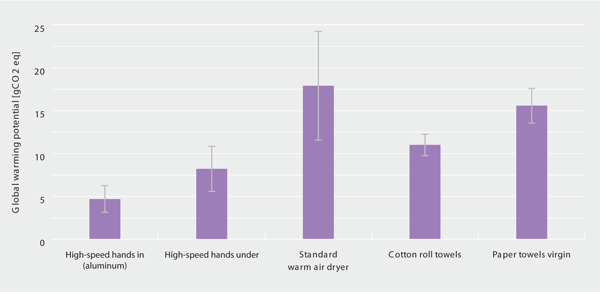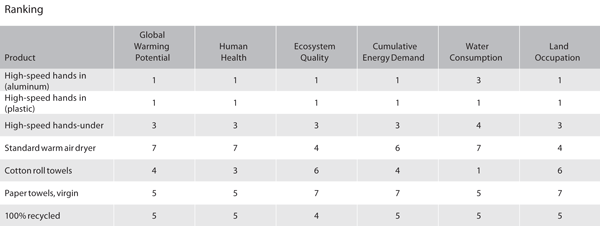Sustainable Hand Drying and Life-Cycle Assessment
Arguments For and Against Paper
The MSL study offered a window into two valuable conclusions for specifiers and their clients: First, that the design of electric hand dryers leads carries impacts to the lifetime results for green building and, second, that paper towels carry high life-cycle impacts that could offset their appeal for other reasons.
“Paper towels,” reads the report, is one of “the two worst-performing types of hand-drying system in terms of environmental impact.” There are several reasons for this, but the study concludes that the majority of the impact comes from the production of the paper towels themselves.
Yet, paper towels are produced in a variety of ways, noted Slate.com environmental columnist Brendan Koerner in a recent industry overview.8 So how will architects know the typical impact for their project? There are variations in how trees are harvested and how much fossil fuel is required for cutting, transporting, pulping and processing of the raw materials. The use of recycled paper will reduce the energy needed by about 40 percent, according to the EPA. Also, the distances from the paper mill to the distribution points to end-users range widely.
Still, environmental groups such as the Climate Conservancy—a scientific nonprofit based in Palo Alto, Calif.—have estimated baseline figures for greenhouse-gas emissions to match the MSL's functional unit. Assuming two towels per session, the GWP cost is 0.123 pounds of CO2 equivalent per pair of dried hands.9 For hand dryers, for various wattages and drying times the Climate Conservancy estimated a range of 0.02 pounds to 0.088 pounds of greenhouse gas produced per pair of dried hands.
“The bottom line,” wrote Koerner, is that hand dryers will be the greener choice in about 95 percent of circumstances.” Yet the difference in energy used is markedly greater when paper-towel drying is compared to high-speed electric dryer technology. This is the second conclusion of the MSL study: that novel high-speed dryers offer substantially better life-cycle performance than standard warm-air dryers.
Standard warm-air dryers ranked last in the MSL review of LCA studies for GWP, with the highest environmental impact. They also had the worst impact in terms of human health and water consumption. For cumulative energy demand, they ranked second to last. High-speed dryers, on the other hand, were ranked first, second and third in all the LCA categories.
The main reason for the good LCA performance is the shorter drying time; for some product designs, the dryer motors do not have spin-down after use or a standby mode in between uses; both of these design features consume energy also.
 |
An LCA comparison has analyzed the differences in GWP impacts between various hand-drying methods. The grey dimension lines show the potential uncertainty in the calculations of GWP, given by the purple bars. Source: Materials Systems Laboratory |
Industrial Design and LCA
Through a single advance in the product design—the switch to high-speed airflow—the life-cycle impact of the restroom changes dramatically. This has been established for at least a decade, following an 2002 LCA study by Franklin Associates showing that recycled towels cost about 460 kilojoules per use—equivalent to one person exercising for about 20 minutes in a health club—while a standard (warm-air) hand dryer requires about 222 kilojoules per effective use.10 If the building occupant only uses one towel for drying, the two methods were shown to be essentially equivalent.
The high-speed dryer category shattered that potential equivalency, always performing best in the LCAs reviewed.
 |
High-speed hand dryers were found to perform well in such categories as GWP, human health and cumulative energy demand. Source: Materials Systems Laboratory |
LCA studies and green building trends in general point up the importance of industrial design for sustainability. Every choice in the design of a high-speed dryer impacts its life-cycle attributes. For example, electric dryer housings are made of metal alloys, aluminum and plastics; the aluminum and metal versions, respectively, tend to the most and second-most energy intensive to manufacture.
But there's more: Both heat and airflow can contribute to water evaporation, and they are used in different ways by various dryer designs. Motor type, performance and spin-down affect how much energy the equipment uses for each restroom user. So does a choice pitting end-user convenience against system efficiency, such as automatic-off features or use of a standby mode rather than simple on-off switching. Form factor is another design variable, such as the orientation of the product and the shape of inlets for entraining air and propelling it to the point of contact at the user's hands. Some hand dryers allow for gravity to assist, for example. Last, there is a significant performance differentiation between standard carbon-brush motors and digital motors, which are found in some products.
The point is that products design is a general life-cycle indicator for building product specification, one that leads many architects to their choice or recommendation. “On our hospitality projects we have found that there is only one dryer type that actually works—the high-speed type—so we try only to spec that kind or recommend it to our clients,” says Joshua Zinder, AIA, LEED AP, NCARB, principal with JZA+D.
Last, there are important questions about public health, sustainability and the overall welfare of the end-user that could affect the ultimate product choice.









